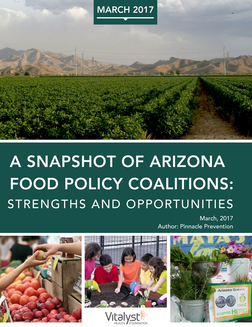It Takes a Village: Collaborating for sustainable and equitable food systems across Arizona4/13/2017  At Pinnacle Prevention, we believe it takes a village to make a meaningful difference. Our state is full of individuals and organizations that are passionate about creating healthy, sustainable, and equitable food systems across Arizona. In March, we released a report that digs in to what these organizations are doing, and how a collaborative statewide network could help improve food systems in communities across the state. These organizations and others work to fill gaps and advance their community’s food system, but each faces similar challenges throughout their work. Each organization featured in the report advocates for a statewide network of collaboration to address many of these challenges, and also enhance success. “By creating a network of networks that shares a vision, collective objectives, and common data,” the report says, “the local organizations will see where they fit in the big picture, where activities align, and how to build and learn from one another.” A statewide network would allow organizations to learn from each other’s challenges and successes, more efficiently monitor and interact with state policies, and promote outreach, education, and equity in local food systems. This kind of collaboration can also increase the capacity of individual organizations to identify sustainable funding opportunities, better analyze and understand data, and reach the vulnerable populations who need their services the most.
“We are far enough along in Arizona in our food system evolution that we are ready for this type of conversation,” Flagstaff Foodlink advisor Liz Taylor said. “We have enough experience of success and challenge and richness of examples to really benefit from work at a statewide level.” Read the report to learn more about what the Ajo Regional Food Partnership, Flagstaff Foodlink, Maricopa County Food System Coalition, Pima County Food Alliance, Pinal Local Food Project, and Yavapai Food Council are doing to create sustainable and equitable food systems across the state, and what could be accomplished by establishing a collaborative statewide network. For examples of successful statewide food system networks, check out Dreaming New Mexico, Minnesota Food Charter, and Michigan’s statewide network.
1 Comment
11/5/2022 01:41:36 am
This kind of collaboration can also increase the capacity of individual organizations to identify sustainable funding opportunities, better analyze and understand data, Thank you for sharing your great post!
Reply
Leave a Reply. |
Pinnacle Prevention BlogFollow our blog for tips, insights and conversations about healthy living. Archives
June 2024
Categories
All
|
Location |
|

